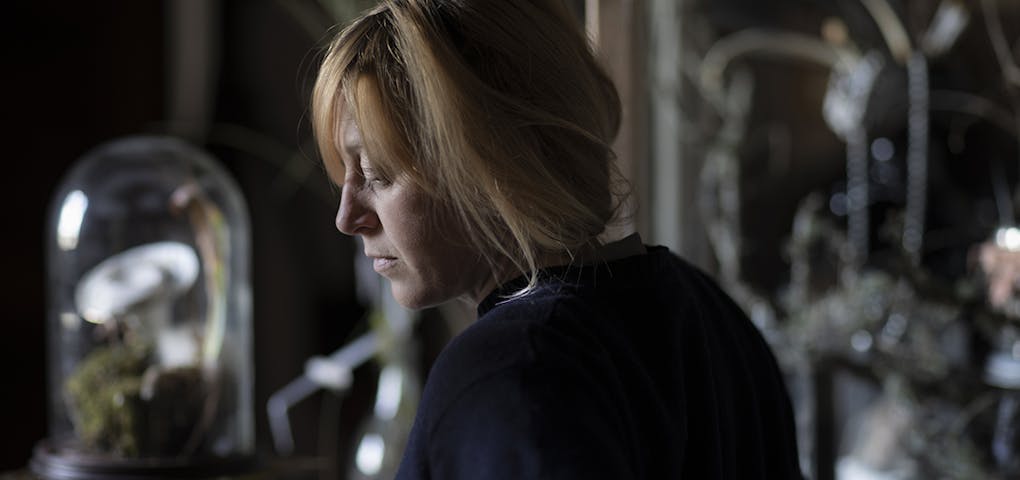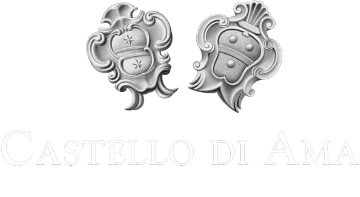SC – First of all, I’d like you to tell me how this work came about.
CB – The Cabinet 2019 project for Castello di Ama came about unexpectedly during the Il mondo infine exhibition, which was held this winter at the National Gallery in Rome….
When the show was still on, I received a phone call, a total surprise, from Lorenza Sebasti; she’d seen my work installed in one of the museum’s halls. As soon as we met at Castello di Ama, I was moved by the enthusiasm with which she suggested I develop a project for Ama… But to answer more fully, Cabinet came about as a continuation of the study that I’ve been conducting for years into objects of everyday use, into a combination between the organic and inorganic, which transform again here, enriching new elements that talk about the place itself, the landscape and, above all, the world of fragrances that Michele Marin creates for Castello di Ama.
SC – There’s no doubt that a thread runs through your research. Not only are there clear links with the Rome exhibition, but also with Wonder Objects 2013, a show that was held at Prato’s Spazio MOO and even (albeit in a less explicit way) with the Still Life installation that we presented at the Arrêts sur image exhibition at Casa Masaccio in 2014. At the same time, each of these projects are independent in their own right, not only due to a different contextualization but also in some way to the intrinsic syntax that, from time to time, similar and different, supports them all. While always starting with the assemblage of materials you’ve found or items that are dear to you, your works seem to give a different horizon every time. For instance, we could say that Wonder Objects 2013 refers to the sculpture for your display that groups together objects into a well-defined centripetal design and that Still Life refers to painting. While offering itself as a complex multimedia installation, the later actually echoes as a vanitas, grappling explicitly with a historicized pictorial genre like still life. The dissemination that characterizes the spatial dislocation of the object nuclei in your hall at the National Gallery refers instead to the installation and, in closing, Cabinet 2019 seems to present itself as a site-specific work…
CB – Your observations seem pertinent to me, yes, … When I created Wonder Objects 2013, I had the idea of monument in mind… I often thought about jewellery boxes that contained body “decor”, which refer to the idea of skin, and whose shape reminds me of the sarcophagi and funerary monuments in many churches in the south of Italy. At that moment, through a set of photographs taken in my studio, a set of elements were outlined that were reminiscent of reliquaries and containers for conservation, which became constants in my works from then on. Cabinet 2019 is undeniably a site-specific work, not only because it was constructed during my stay in Ama, which lasted about two and a half weeks, but also because it does not grapple with a neutral space, like all spaces dedicated to art, but instead as a space that’s actually inhabited. It’s a domestic space: a former kitchen where there was already a marble table, a material that often recurs in my art, a place that can house many of the elements (bottles, glasses, cups, etc.) that constitute the raw materials of my research. Hence, it’s as if this installation had always been there and the objects had found their places again in a sort of journey back in time and memory.
SC – Although all your works, at least your art to date, originate in an inhabited space, like your studio, a place where you live and work, they are destined for exhibition in neutral and, to some extent, aseptic spaces, so they suffer a sort of decontextualization every time. On this occasion, it seems that the process panned out differently…
CB – Because everything begins in my study, it’s always a partial decontextualization, even though on this occasion things went a little differently. Whilst for the exhibition il mondo infine I practically moved from Prato to Rome to have greater availability to the materials with which to work in the museum, in this case the macro-relocation sparked a merger with the environment. Day after day, in Ama, adding unexpected materials to the installation came spontaneously to me, “things” that I found locally, natural materials that began to invade the room, in an attempt to create a new internal landscape that melded with the room itself. With the introduction of natural materials, as well as liquids, the work underwent a continual material transformation, given by the changing organic elements that partly composed it… a gradual mutation that also refers to the precariousness and instability of life…
Moreover, through talking with Lorenza, the idea emerged to create a situation for a few onlookers at a time, a sort of cabinet of curiosities in which the internal sensory experience is felt in a personal way…
The suggestion sparked a series of stimuli, which led to ideas that became clearer and more tangible during the work process through correspondences, continual references and new intuitions.
The new work took shape by blending my past work, which became more current through new discoveries and materials that I had the chance to experiment thanks to this occasion. In addition to the visual experience, I also worked on the olfactory experience, collaborating with Michele, who introduced me to the world of essences, allowing me to include what I like to call odorous “matter” in my research. Hence, the work took shape in situ, proceeding from an impulse that’s never planned but that emerges as I create the work. The Ama project is perfectly at one with my modus operandi, which reflects a condition of being that’s natural and instinctive, where the “things” that happen in front of us aren’t sought, but found.
Another new factor that characterized the Ama experience was the participation of people who helped me to create the work, immediately showing a sort of spontaneous affection for the art, which became a natural part of the place.
SC – Did working in a context like Ama, as opposed to the abandoned and ruined industrial places that have distinguished your studies to date, change your modus operandi in any way?
CB – Working in close contact with a different landscape and new materials generated original variations of my work, not only creating Cabinet 2019 but also creating new works that are currently under development in my studio. These works came from the collection of natural materials I’ve found along the route I’ve travelled and often travel between Prato and Chianti at this time. In my most recent sculptures, the natural dimension prevailed over the object. Through an insistent attempt to merge residual artificial materials, like debris and ruined objects from accidental mistakes in compositions, I created original combinations, which are outlined through repeated poses before being turned into continual still lifes in which the landscape between particular macros and micros alternate in a play on references and repetitions that always offer a new image. The experience of time spent in Ama was fundamental for a further transformation of my study, which has embraced the natural elements even more.
Biographies
- Chiara Bettazzi (1977) lives and works in Prato. Artist and founder of the via Genova former industrial space. She has investigated contemporary languages in Prato’s industrial landscape for years, through which she implements shared interventions that reflect upon industrial and cultural heritage. In 2005, she opened Studio SC17 through which she reactivated the former Lanificio Bini mill area. Her work is linked to a reflection on objects of repurposed everyday use, in which the need persists to change the identity of things through various media.
Her artistic practice moves along the thin pathological line typical of contemporary society, on one hand focused on the disposable and, on the other hand, directed at the compulsive accumulation of objects of dubious utility, a poetics associated with memory, time and an incessant attempt to blend organic and inorganic matter. Over the years, she has participated in exhibitions in museums and privately owned spaces, including the following: 2018 – Il Mondoinfine: vivere tra le rovine. Curated by Ilaria Bussoni, La Galleria Nazionale d’Arte Moderna e Contemporanea, Rome; 2017 – What about my objects? Solo show – Localedue Bologna. Curated by Alessandro Gallicchio; 2017- Madeinfilandia, artist’s residence at Filanda in Pieve a Presciano (AR); 2017 – Sensibile Comune – curated by Ilaria Bussoni, Nicolas Martino and Cesare Pietroiusti - Galleria Nazionale D'Arte Moderna e Contemporanea Roma; 2015 – Ripensare il Medium – Il fantasma del disegno. Curated by Saretto Cincinelli and Cristiana Collu. Casa Masaccio, San Giovanni Valdarno; 2014 - Arrêts sur images curated by Saretto Cincinelli, Casa Masaccio Centro per l’arte contemporanea San Giovanni Valdarno Arezzo; 2013 - L’Economia del dono, Dryphoto, Prato; 2011 – 54th Biennale d’Arte Tuscany Pavilion curated by Marco Bazzini, Museo Pecci Prato; 2010 - Gemine Muse, Trame d’arte identità e inganni, curated by Stefano Pezzato, Museo del Tessuto Prato.
- Saretto Cincinelli (1956) is a critic and curator. He has contributed to Flash Art(Milan) and Ars Mediterranea (Barcelona) and his writings have been published in other art journals, catalogues and monographs, such as Tony Cragg formations and Form, BSI Art collection, Zurich; Daniela De Lorenzo, La Galliera, Valencia; Soulages XXI° Siècle, Musée de Beaux Art de Lyon, La Magnifica Ossessione, Mart Rovereto. His most recent curated or co-curated exhibitions include the following: 2007-2012, L’evento Immobile, an annual event promoted by Museo Man, Nuoro and Casa Masaccio, San Giovanni V.no; 2009: Mark Lewis, Man, Nuoro and Museo Marini, Florence; Emanuele Becheri, Man, Nuoro; 2010: Luca Rento, Cairn Centre d’art, Digne; 2011: David Claerbout, Mart, Rovereto; 2013: Andrea Santarlasci, San Michele degli Scalzi, Pisa; 2015: Luce Coatta: Dischiusure (Banal, Catelani, Meoni), Artopia, Milan; Carlo Guaita, Artopia, Milan; La guerra che verrà non è la prima Mart, Rovereto; 2016: Un sogno fatto a Mantova, Palazzo Te, Mantua; 2016/17: The Lasting, La Galleria Nazionale, Rome; 2016/18 Time is out of Joint La Galleria Nazionale, Rome; Il disegno del disegno, Museo Novecento, Florence, 2018-19; Joint is out of Time, La Galleria Nazionale, Rome,
Foto: Alessandro Moggi

